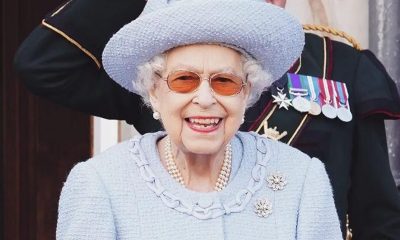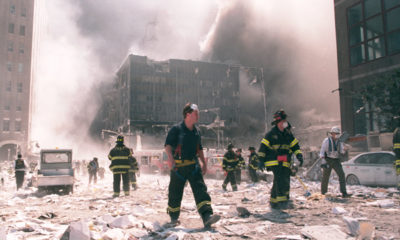Living
From the archives: Gays among heroes, victims of Sept. 11
Our archives piece profiling many of the LGBT dead found in the 5th anniversary of the Sept. 11 attacks issue.

This piece ran in the Blade’s five-year anniversary issue in September 2006. It lists some of the known LGBT victims of the Sept. 11 attacks and shows that families of all types were affected by the terrible events of that tragic day. It also shows that many of the 9/11 heroes who saved countless lives were lesbian, gay, bisexual or transgender.
RENEE BARRETT-ARJUNE
Irvington, N.J.
Renee Barrett-Arjune, 41, was working in One World Trade Center at the time of the attacks. An accountant for Cantor Fitzgerald, she was able to escape the building prior to its collapse.
However, she suffered serious burns in the attack, and was hospitalized at Cornell-Presbyterian Hospital, where she died more than a month later on Oct. 18, 2001.
Barrett-Arjune had been a member of the Metropolitan Community Church of New York. She left behind her partner, Enez Cooper, and her 18-year-old son, Eddie, who lived with them.
GRAHAM BERKELEY
Boston
Graham Berkeley, 37, a native of England who lived in Boston, boarded United Airlines Flight 175 on Sept. 11, 2001, on his way to a conference in Los Angeles. He died when the plane became the second highjacked airliner to crash into the World Trade Center.
Berkeley’s parents, Charles and Pauline Berkeley, still live in England and watched the crash on television, although it took eight hours to confirm that their son had been on the plane.
“We had seen the fireball ourselves and knew to expect the worst,” Charles Berkeley told the London Mirror. “We watched our child die. He was a brilliant boy, a brilliant man.”
Graham Berkeley worked for Compuserve as product management director and was a professional violinist in Germany and England, the Advocate reported.
MARK BINGHAM
San Francisco
Gay rugby enthusiast Mark Bingham has been hailed as one of a small group of heroes who fought back against hijackers on United Flight 93, which crashed in Pennsylvania. The flight was believed to have been headed to Washington, D.C., likely to attack another national landmark.
Bingham, 31, was a member of the San Francisco Fog, a gay rugby team, and planned to organize a rugby team for this year’s Gay Games in Sydney, Australia.
A tribute page hosted by the team includes an e-mail from Bingham after he had learned that the Fog had been accepted as a permanent member of the California Rugby Football Union.
“Gay men weren’t always wallflowers waiting on the sideline,” he said, applauding the team’s acceptance into the league. “We have the opportunity to let these other athletes know that gay men were around all along — on their little league teams, in their classes, being their friends.”
PAMELA J. BOYCE
New York
Pamela J. Boyce, 43, was a resident of Dyker Heights, Brooklyn, and worked on the 92nd floor of One World Trade Center as assistant vice president of accounting for the New York office of Carr Futures.
Catherine Anello, Boyce’s partner, told the New York Times that Boyce was a no-nonsense person who wouldn’t want her loved ones to be overcome by grief.
“If there was someone who lost a loved one and had been grieving too long, so that they were not living their life, she would say, ‘Stop. It’s not what they would want. They are in a better place.'” Anello said, “She said, ‘I’m not afraid to die because I know where I am going is beautiful.'”
DANIEL BRANDHORST
RONALD GAMBOA
DAVID REED GAMBOA BRANDHORST
Los Angeles
When Daniel Brandhorst and Ronald Gamboa changed their flights so they could return to Los Angeles from Boston on Sept. 11 with adopted son, David, they had no idea of the tragedy that would await them.
Brandhorst and Gamboa had met 13 years ago at a party. Family friend Donato Tramuto told the New York Times Gamboa “could make a rainy day look happy.” Meanwhile, Scott Pisani, a fellow employee at PriceWaterhouseCoopers, said Brandhorst “made a tremendous amount of time for his family” after David was born, and would often take the toddler to work.
David, 3 at the time of his death, was adopted at birth by Gamboa and Brandhorst. Brandhorst, 41, worked an accountant for PriceWaterhouseCoopers, and Gamboa, 33, was the manager of a Gap store. They were on United Airlines Flight 175.
DAVID CHARLEBOIS
Washington, D.C.
David Charlebois, 39, first officer on American Airlines Flight 77, which collided into the Pentagon after being hijacked by terrorists, died while flying one of his standard routes.
Charlebois lived near the District’s popular Dupont Circle neighborhood with his partner of 14 years, Tom Hay, and their border collie, Chance.
He began his career as a pilot for corporate executives and later worked as a pilot for U.S. Airways. He joined American Airlines a decade ago, where he served as first officer, or co-pilot, flying mostly transcontinental routes out of Dulles International Airport.
Hay said Charlebois’ loyalty to his friends, family, and community was rivaled only by his love for flying.
“He always wanted to be a pilot,” Hay said.
Charlebois was an active member of the National Gay Pilots Association and had worked quietly within his company as an advocate for rights of gay employees, including gay pilots.
EUGENE CLARK
New York
Eugene Clark, 47, observed “the three D’s: dance, drama and divas,” according to the New York Times. His partner of 13 years, Larry Courtney, said Clark had grown up listening to Roberta Flack, loved Broadway musicals and could dance “like Tina Turner… and he had legs almost as good.”
Clark worked for the Aon Corporation as an administrative assistant, but it was his time away from the office that he enjoyed most. He had converted a 10-foot by 24-foot concrete-slab patio into a thriving terrace garden.
He also “adored the musicals ‘Miss Saigon’ and ‘Les Miserables,’ cooked Southern-style fried cabbage, and collected Waterford crystal decanters and vases,” the Times reported.
JEFFREY COLLMAN
Jeffrey Collman, 41, a flight attendant on American Airlines Flight 11, died when the hijacked jet slammed into the North World Trade Center tower in the first attack of Sept. 11, 2001.
A three-year employee of American Airlines, Collman had changed to the Boston-Los Angeles route from his normal Boston-San Francisco flights in order to prepare for an upcoming vacation.
Keith Bradkowski, Collman’s partner, had last heard from him the evening prior to the crash, when Collman called to talk about their upcoming trip, according to the San Jose Mercury News.
Collman received the American Professional Flight Attendant Award in 1999. In addition to Bradkowski, the Illinois native was survived by one sister and four brothers.
LUKE DUDEK
Livingston, N.J.
Luke Dudek and his partner of 20 years, George Cuellar, had dreamt of buying a building to house their high-end floral design store.
On Sept. 11, 2001, that dream finally became a reality. But Dudek, 50, wasn’t there to celebrate, according to Newsday.com.
Dudek was working as a food and beverage controller at Windows on the World, the restaurant at the top of One World Trade Center, that morning, when terrorist planes struck the building.
Dudek’s partner, George Cuellar, continues to run the flower shop he operated with Dudek for 16 years. He said the couple had no regrets in life.
“Everything we did, we did with love,” Cuellar told Newsday. “He’ll always be my best friend. I feel very protected by him. And I always did.”
JOE FERGUSON
Washington, D.C.
James Joe Ferguson, director of geography education outreach for the National Geographic Society, was on American Airlines Flight 77 when it crashed into the Pentagon. Ferguson was traveling on a National Geographic-sponsored educational field trip to the Channel Islands National Marine Sanctuary off Santa Barbara, Calif.
Ferguson, 39, was accompanying a colleague, three teachers, and three sixth-grade students, all from Washington, on the trip.
Ferguson lived on Capitol Hill for 10 years with Winston, his wire-haired fox terrier. He was one of the principal architects who designed the infrastructure of geography education, which resulted in the improvement of geography education throughout the United States, according to National Geographic.
“Ultimately, what he did touched over 150,000 students and teachers — and that is just one person,” said Ed Kaczmarek, a friend of Ferguson’s for 14 years.
CAROL FLYZIK
Plaistow, N.H.
Carol Flyzik, a 40-year-old registered nurse and a member of the Human Rights Campaign, was on American Airlines Flight 11 on her way to California when her plane became the first to crash into the World Trade Center.
Flyzik was a marketing supervisor for Meditech, a software company that serves the medical community. She was headed to California on a business trip at the time.
She left behind a partner of nearly 13 years, Nancy, as well as three stepchildren whom she cared for as her own.
SHEILA HEIN
University Park, Md.
Sheila Hein, an analyst, was working for the U.S. Army’s management and budget office in the Pentagon when American Airlines Flight 77 crashed into it.
Hein, 51, lived with her partner of 17 years, Peggy Neff, in University Park, Md. They bought a house there seven years ago as a “fixer-upper” and turned the backyard into their “own private park,” Neff told the Washington Post. “She is what this yard is. There’s a whole lot of love here,” Neff said.
Hein worked at the Pentagon for the last five years as a visual information specialist for the Army and had only recently changed jobs. She was at the Pentagon that day taking part in an Army internship, studying manpower analysis. A native of Springfield, Mass., she joined the Navy after high school and was sent to Virginia. She spent 10 years in the service as a photographer, married twice, and ventured into a career in computer graphics, working on government contracts.
Hein received a bachelor’s degree from Columbia Union College three years ago after taking courses on and off for 20 years. “She decided it was time to finish it,” Neff told the Post. She planned to get a master’s degree.
MYCHAL JUDGE
New York
New York City Fire Department Chaplain Mychal Judge was killed during the collapse of the World Trade Center towers while administering last rites to a dying firefighter. Fellow firefighters carried his body to St. Peter’s Church and then back to the firehouse.
Judge, 68, had been a Catholic chaplain for the New York City Fire Department since 1992. “Father Mike,” as the gay priest was known, was laid to rest in a memorial service attended by more than 3,000 and presided over by Cardinal Edward M. Egan.
Judge was also a “longtime member” of Dignity/USA, according to the Web site of the organization for “gay, lesbian, bisexual and transgendered Catholics, our families and friends.”
WILLIAM ANTHONY KARNES
New York
William Anthony Karnes and his partner, John Winter, could see Karnes’ office at Marsh & McLennon on the 97th floor of One World Trade Center from the home they shared.
On the morning of Sept. 11, 2001, the 37-year-old Karnes left for the office as usual at 8:30 a.m. The “commute,” which took about 11 minutes, would be his last. At 8:45, Winter heard what sounded like a thunder, and immediately looked out his apartment window.
“At that point, I knew probably a lot of hope was lost that I’d ever see him again,” Winter told LGNY. “Death doesn’t discriminate. Death actually transcends sexual orientation.”
JACK KEOHANE
New York
John Keohane, 41, worked at One Liberty Plaza near the World Trade Center and died when the towers collapsed. After the planes hit the Trade Center towers, Keohane met Mike Lyons, his partner of 17 years, on the street, and called his mother from his cell phone.
“They were just in the streets like everybody else,” his sister, Darlene Keohane, told the San Francisco Chronicle. “As he was talking, he had thought a third plane crashed into the building.”
What Keohane thought was a third crash was really the collapse of the South tower of the World Trade Center. While Lyons survived, Keohane was killed by falling debris.
A native of San Francisco, Keohane had lived in the New York area for a year. Distraught over Keohane’s death, Lyons committed suicide on March 1.
MICHAEL LEPORE
New York
Michael Lepore’s friends now take care of his rosebushes and plants in the garden that had been his pride and joy.
“We used to say nothing bad could ever happen here,” Lepore’s partner of 18 years, David O’Leary, told the New York Times. “And it’s still the most important thing. It’s where I see most of Michael.”
Lepore, 39, was a project analyst at Marsh & McLennan. He shared a home, designed by Frank Lloyd Wright apprentice Edgar Tafel, with O’Leary and their three cocker spaniels, and the couple was in the midst of helping to plan Lepore’s youngest brother’s wedding.
O’Leary said, a month prior to the attacks, their house had been bustling with friends and family.
“Everything was so perfect in our lives,” he said. “Just so perfect.”
PATRICIA McANENEY
New York
Patricia McAneney, 50, always wanted to be a firefighter. While she never actually became one, she did serve as fire marshal for the floor in One World Trade Center where her employer, Guy Carpenter insurance company, had its offices.
Her friends and partner remembered her for her honesty.
“If one of us committed a crime, Pat would be the last person we could go to because she would turn you in,” McAneney’s partner of nearly 20 years, Margaret Cruz, told the New York Times. “She said she might give me a few hours’ head start.”
WESLEY MERCER
New York
Wesley Mercer, the vice president of corporate security for Morgan Stanley, was generally a quiet man. But his partner, Bill Randolph, told the New York Times that Mercer also could be a leader during a crisis.
That’s what he did on Sept. 11, 2001. The World Trade Center towers fell as Mercer helped evacuate other employees
“It put a hole in my stomach,” Randolph told the paper. “But I knew that’s what he would have done.”
Mercer, who was divorced and had two daughters, became a security officer after serving in the military, and was known for his formal style. “He always thought the way he carried himself was important,” Randolph said.
PHILIP “ROXY EDDIE” OGNIBENE
New York
“Roxy Eddie” Ognibene, a member of the Renegades of New York’s Big Apple Softball League, was killed last Sept. 11 while working as a bond trader for Keefe, Bruyette & Woods on the 89th floor of Two World Trade Center, according to Outsports.com.
Ognibene, 39, was considered by his friends to be “a strong lefty hitter, a flawless first baseman,” and a solid pitcher and outfield player, the gay sports Web site reported. Those who knew him said his sense of humor was contagious, and just to see him was to laugh out loud.
Although his work often left him too busy to pursue outside hobbies, Ognibene had a love of softball and had just recently joined the league. During one particularly nasty practice, which occurred in the middle of a downpour, Ognibene was the last to leave the field.
“I don’t care,” he said, friend Ben Moon recounted to Outsports. “I just love to play softball.”
CATHERINE SMITH
New York
Catherine Smith, 44, worked on the 92nd floor of the first World Trade Center tower as a vice president for Marsh & McLennon when tragedy struck last Sept. 11.
Smith and her partner of six years, Elba Cedeno, considered themselves very similar to Pepe Le Pew and Penelope from the Looney Tunes cartoons, according to the New York Times. “They had known each other, in passing, for 20-odd years, both frequenting the same bar,” the paper reported. Later, when both had ended other relationships, they officially met.
The two were together for six years.
“This was my soul mate. We planned to live the rest of our lives together and retire together,” Cedeno said.
From staff and wire reports
Real Estate
Celebrate the power of homeownership this Fourth of July
Owning a home is powerful act of self-determination

This Fourth of July, celebrate more than independence: celebrate the power of LGBTQ+ homeownership. Explore resources, rights, and representation with GayRealEstate.com, the trusted leader in LGBTQ+ real estate for over 30 years.
Home is more than a house: it’s a symbol of freedom
As the fireworks light up the sky this Fourth of July, LGBTQ+ individuals and families across the country are not just celebrating the nation’s independence — they’re celebrating personal milestones of freedom, visibility, and the right to call a place their own.
For many in the LGBTQ+ community, owning a home represents more than stability — it’s a powerful act of self-determination. After generations of discrimination and exclusion from housing opportunities, more LGBTQ+ people are stepping into homeownership with pride and purpose.
Why homeownership matters to the LGBTQ+ community
While progress has been made, LGBTQ+ homebuyers still face unique challenges, including:
- Housing discrimination, even in states with legal protections
- Limited access to LGBTQ+ friendly realtors and resources
- Concerns about safety and acceptance in new neighborhoods
- Lack of representation in the real estate industry
That’s why the Fourth of July is a perfect time to reflect not just on freedom as a concept, but on how that freedom is expressed in the real world — through ownership, safety, and pride in where and how we live.
Finding LGBTQ+ Friendly Neighborhoods
One of the top concerns for LGBTQ+ buyers is whether they’ll feel safe, accepted, and welcome in their new neighborhood. Thanks to evolving attitudes and stronger community support, many cities across the U.S. now offer inclusive, affirming environments.
Some of the best cities for LGBTQ+ home buyers include:
- Wilton Manors, Fla. – A vibrant LGBTQ+ hub with strong community ties
- Palm Springs, Calif. – A longtime favorite for LGBTQ+ homeowners
- Asheville, N.C. – Progressive and artsy, with growing LGBTQ+ visibility
- Portland, Ore. – Inclusive, eco-conscious, and diverse
- Philadelphia, PA – Rich in history and LGBTQ+ community leadership
When you work with an LGBTQ+ friendly realtor, you get insight into more than property values — you get a real perspective on where you’ll feel most at home.
Navigating the real estate process with confidence
Whether you’re a first-time gay homebuyer or preparing to sell your home as an LGBTQ+ couple, it’s essential to understand your rights and options. Here are a few key tips:
1. Work with a trusted LGBTQ+ real estate agent
Representation matters. A gay realtor, lesbian real estate agent, or LGBTQ+ friendly agent understands the unique concerns you may face and advocates for you every step of the way.
Use GayRealEstate.com to connect with LGBTQ+ real estate agents near you. For over 30 years, we’ve helped LGBTQ+ buyers and sellers find their ideal home and a professional who respects their identity.
2. Know your legal protections
While federal law (via the Fair Housing Act and Supreme Court rulings) prohibits housing discrimination based on sexual orientation or gender identity, enforcement can vary by state. Make sure to research:
- State-level housing discrimination laws
- Local LGBTQ+ protections and resources
- What to do if you experience discrimination during a transaction
3. Secure inclusive financing
While most lenders follow fair lending rules, it’s smart to seek out banks or credit unions with LGBTQ+ inclusive policies and a history of non-discriminatory lending practices.
4. Plan for the future as a family
For same-sex couples, especially unmarried partners, it’s vital to review how you’ll hold the title, designate beneficiaries, and plan your estate.
Ask your agent or attorney about:
- Joint tenancy with right of survivorship
- Living trusts
- Powers of attorney and healthcare proxies
Selling a home as an LGBTQ+ homeowner
If you’re listing your home, working with a gay-friendly real estate agent ensures your identity and story are honored — not hidden — in the process.
Highlight:
- Your community connections
- Your home’s role in creating a safe space
- Local LGBTQ+ resources to attract like-minded buyers
Showcasing the full value of your home includes sharing what it meant to live there authentically and safely.
Your home, your freedom
The Fourth of July reminds us that freedom isn’t just an abstract idea — it’s lived every day in the spaces where we find comfort, love, and belonging. For the LGBTQ+ community, the right to own and thrive in a home is part of the larger journey toward full equality.
At GayRealEstate.com, we believe every LGBTQ+ person deserves:
- A safe place to live
- A community that welcomes them
- An advocate in the home buying or selling process
Ready to make a move?
Whether you’re dreaming of your first home, upgrading with your partner, or selling a space that helped shape your identity, GayRealEstate.com is your trusted partner. With our nationwide network of gay realtors, lesbian real estate agents, and LGBTQ+ friendly professionals, we make your journey smooth, respectful, and informed.
Visit GayRealEstate.com to:
- Search LGBTQ+ friendly homes
- Connect with inclusive real estate agents
- Access free guides for buyers and sellers
- Protect your rights and get expert advice
This Fourth of July, celebrate more than independence — celebrate your freedom to live, love, and own with pride.

Did you melt like the Wicked Witch of the West this week?
As summer temperatures rise, keeping your home or apartment cool during a heat wave can become both a comfort issue and a financial challenge. One of the most effective ways to keep a home cool is to prevent heat from entering in the first place. Sunlight streaming through windows can significantly raise indoor temperatures. Consider the following solutions:
• Close blinds or curtains during the hottest parts of the day. Blackout curtains or thermal drapes can reduce heat gain by up to 30%.
• Install reflective window films to block UV rays and reduce solar heat without sacrificing natural light.
• Use outdoor shading solutions such as awnings (yes, the ones you removed because they were “dated”) and shutters to limit direct sunlight.
Fans are a cost-effective way to circulate air and create a wind-chill effect that makes rooms feel cooler.
• Ceiling fans should rotate counterclockwise in the summer to push cool air down.
• Box fans or oscillating fans can be placed near windows to pull in cooler evening air or push hot air out.
• Create a cross-breeze by opening windows on opposite sides of your home and positioning fans to direct airflow through the space.
• For an extra cooling effect, place a bowl of ice or a frozen water bottle in front of a fan to circulate chilled air.
To optimize natural ventilation, open windows early in the morning or late in the evening when outdoor temperatures drop. This allows cooler air to flow in and helps ventilate heat that built up during the day.
Appliances and electronics generate a surprising amount of heat. To reduce indoor temperatures:
• Avoid using the oven or stove during the day; opt for no-cook meals, microwave cooking, or grilling outside.
• Run heat-producing appliances like dishwashers and clothes dryers in the early morning or late evening.
• Unplug electronics when not in use, as even standby power can add heat to your space.
• Switching to energy-efficient LED lightbulbs can also reduce ambient heat compared to incandescent lighting.
If you do use an air conditioner, maximize its effectiveness by:
• Setting it to a reasonable temperature—around 76–78°F when you’re home and higher when you’re away.
• Cleaning or replacing filters regularly to maintain airflow and efficiency.
• Sealing gaps around doors and windows to prevent cool air from escaping. (Didn’t we all have a parent who said, “Close the door. You’re letting all the cool out?”)
• Using a programmable thermostat to optimize cooling schedules and reduce energy use.
If it is not cost-prohibitive, adding insulation in attics and walls can greatly reduce heat transfer. Solar panels that reflect heat can also help, as well as offset the cost of their installation. Adding weatherstripping around doors and windows, sealing cracks, and using door sweeps can make a significant difference in keeping heat out and cool air in.
Natural and eco-conscious methods can also help cool your home.
• Snake plants, ferns, or rubber trees can improve air quality and slightly cool the air through transpiration.
• White or reflective roof paint can reduce roof temperatures significantly.
• Cooling mats or bedding can make sleeping more comfortable without cranking up the A/C.
For renters or those who can’t make permanent modifications, there are still plenty of ways to keep cool.
• Use portable fans and A/C units instead of built-in systems, making sure they are the correct size for your space.
• Removable window film or static cling tinting can reflect heat without violating your lease.
• Install tension rod curtains or temporary blackout panels instead of hardware-mounted window coverings.
• Add draft blockers and weatherstripping tape that can be applied and removed without damage.
• Cover floors with light-colored rugs to reflect heat rather than absorb it.
• If allowed, use temporary adhesive hooks to hang reflective materials or light-filtering fabrics over windows.
Even if your space is warm, you can still take steps to help your body stay cool.
• Wear light, breathable fabrics like cotton or linen.
• Stay hydrated and avoid caffeine or alcohol during peak heat hours.
• Take cool showers or use damp cloths on your neck and wrists to bring your body temperature down.
Keeping your home or apartment cool in the summer doesn’t have to be expensive or energy-intensive. With a few adjustments such as blocking sunlight, optimizing airflow, using fans effectively, and making renter-friendly upgrades, you can create a more comfortable indoor environment while keeping energy bills in check.
Valerie M. Blake is a licensed Associate Broker in D.C., Maryland, and Virginia with RLAH @properties. Call or text her at 202-246-8602, email her at DCHomeQuest.com, or follow her on Facebook at TheRealst8ofAffairs.
Real Estate
The world’s on fire and D.C. is on sale (sort of)
Prices are up, but then again, nothing makes sense anymore

ICE is disappearing people, revered government agencies are shuttering, and who knows if we’ll be in World War III next week? But can you believe prices in D.C. are actually still up 6.3% since last year? It doesn’t make sense, and perhaps that does make sense, because nothing seems to make any sense any more.
That said, there are some parts of our market that are truly suffering. The interest rates, which have been up, up, up for about four years now, are the ongoing rain on our market’s military parade. Combine that with 75,000 federal employees taking a buyout nationwide, and DOGE cuts eliminating around 40,000 federal jobs in the District (per estimates by the D.C. CFO), not to mention thousands of other job losses in non-governmental organizations due to funding and program cuts, and you’ve got a case of uncertainty, and downright unaffordability in the pool of otherwise would-be buyers.
This has had a marked impact on properties that starter-home buyers and low- to mid-level employees would otherwise buy, most notably condominium and cooperative apartment units. These properties have already slowed in our market thanks to the profound impact that higher interest rates have had on their monthly carrying costs—pair that with job insecurity, and a lot of condos are proving to be very difficult to sell indeed.
So how is the average sale price up in our market?
The increase is almost entirely due to the resounding strength of the single-family home market, especially in upper Northwest D.C., where it is still quite common to see bidding wars, even on properties pushing past the $3M mark. It seems that buyers in that echelon are less impacted by a few percentage points in the interest rate, and less concerned about their job security. Notably, those buyers are often married with children and have an absolute need for more space, must stay in the area due to one spouse’s job, or the kid’s friend group, regardless of whether the cost of owning is thousands of dollars more per month than it would have been in 2020 or 2021. The continued appreciation in these neighborhoods defies imagination.
So, what to do if you are not one of those lucky enough to be shopping for a $3M home? The short answer: wait. If you want more space, rent your current place out and learn the joys of being a landlord while someone else pays your mortgage. Need the equity from your current home to buy your next place? Get a home equity line of credit, or loan, and pull the equity out of your current place to buy the next one. Or—and I have never recommended this before in 21 years of being a Realtor—rent for a few years. Sure, I’d love to list and sell your condo so you can climb the real estate ladder, but it might just be a waste of time, money or both if you could just ride out this storm and sell in a DOGE-less future.
All this said, there are some condos that seem to be immune from this recent negative news. Anecdotally, it feels like it’s the truly special ones that do just fine no matter the market. Our recent listing in Capitol Hill had a view from every one of its 15 windows of the Supreme Court. Sold in five days with six offers. Another condo was on the top two floors of a townhouse and had the coolest black wood floors that gleamed like a grand piano. Sold in four days at full price.
So, all is not for naught if you have a condo or home in an area that people want to be in, with nice space, light, amenities and a certain je ne sais quois. And, as long as we have a democracy in a few years, my experience says our market will be back, stronger than ever, really soon.
David Bediz is a Realtor and mortgage loan broker for the Bediz Group LLC and Home Starts Here, LLC. Reach him at [email protected].
-

 U.S. Supreme Court2 days ago
U.S. Supreme Court2 days agoSupreme Court to consider bans on trans athletes in school sports
-

 Out & About2 days ago
Out & About2 days agoCelebrate the Fourth of July the gay way!
-

 Virginia2 days ago
Virginia2 days agoVa. court allows conversion therapy despite law banning it
-

 Maryland4 days ago
Maryland4 days agoLGBTQ suicide prevention hotline option is going away. Here’s where else to go in Md.












